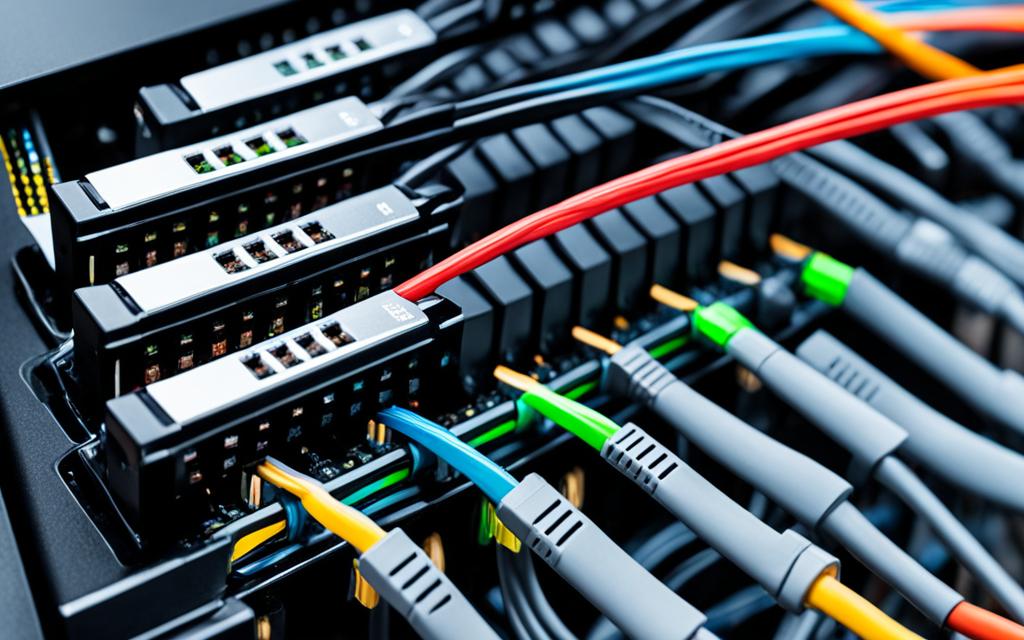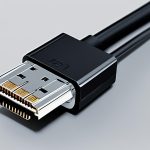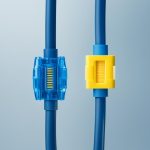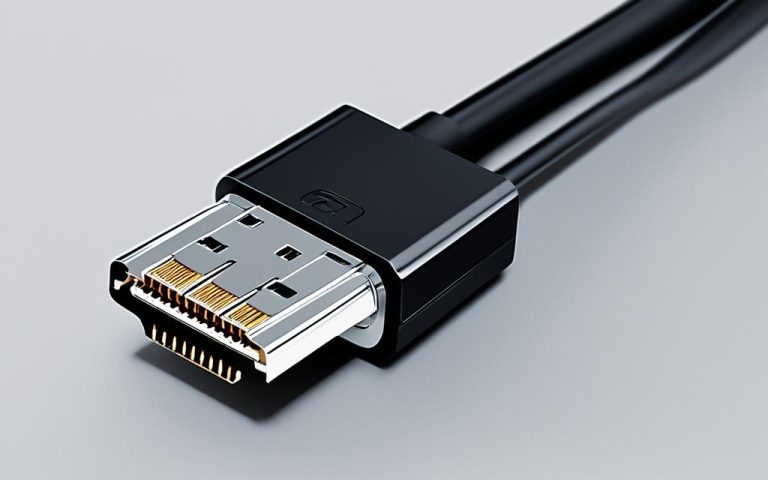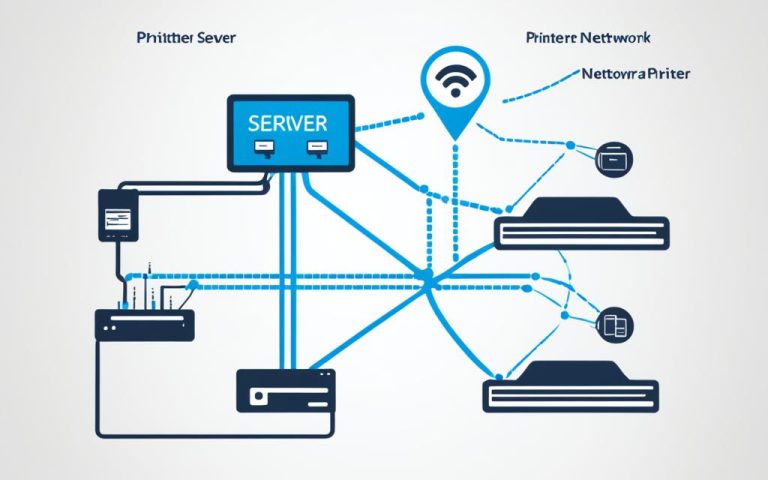Gigabit Ethernet switches are key for networks, letting devices talk and access the internet fast. They support speeds up to 1 Gigabit per second (Gbps)1. These switches come with different port numbers, from two to 50 or more1.
Gigabit Ethernet uses all four pairs of cables for sending and receiving data1. This makes data transfer faster and more efficient than Fast Ethernet. Gigabit switches are ten times quicker than Fast Ethernet, offering speeds up to 1 Gbps1. They connect devices like computers, printers, cameras, and HD TVs to the network1.
Some Gigabit switches might be pricier due to their speed, number of ports, quality, features, brand, and energy efficiency1. But, their benefits like faster data transfer and better network performance make them worth it.
Gigabit switches are used in many places. They’re perfect for IP metropolitan area networks, large campus networks, and enterprise networks needing high-speed data transfer2. Fast Ethernet switches are better for small to medium businesses, schools, and home offices because they’re cheaper2.
Gigabit switches have many features for various uses. They offer advanced features like Power over Ethernet (PoE), link aggregation, Quality of Service (QoS), VLAN support, and higher switching capacities than Fast Ethernet switches2. These features help manage networks better, improve security, and boost performance.
Key Takeaways:
- Gigabit network switches provide high-speed connectivity with data transfer rates of up to 1 Gbps1.
- They can have varied numbers of ports ranging from two to 50 or more1.
- Gigabit Ethernet utilizes all four pairs of twisted-pair cables for transmission and reception1.
- Gigabit switches offer data speeds of up to 1 Gbps, ten times faster than Fast Ethernet1.
- The cost of Gigabit switches may vary based on factors like speed, ports, build quality, advanced features, brand reputation, and energy efficiency1.
- Gigabit switches are commonly used in IP metropolitan area networks, large campus networks, and enterprise networks where high-speed data transfer is required2.
Features of Gigabit Network Switches
Gigabit network switches are key for modern networks. They support speeds of 10/100/1000 Mbps for copper cables and 1000 Mbps for fiber optic cables. This means fast and reliable data transfer. They come with various ports, from two to 50 or more, fitting different network sizes.
These switches have RJ45 connector ports for copper networks and SFP ports for fiber optic cables. This makes them easy to fit into different networks. The Gigabit Network Switches series has options like 16-Port/24-Port with 10/100/1000Mbps Ethernet RJ-45 ports3.
Switches can be managed or unmanaged. Managed switches, like those from Planet Technology USA, offer advanced features like VLAN support and remote management. Unmanaged switches are plug-and-play and easy to set up. The UTP3316-M0 model has 16*10/100/1000Base-T RJ-45 ports, and the UTP3324-M0 model has 24*10/100/1000Base-T RJ-45 ports3.
Gigabit network switches have LED indicators for status and activity. These indicators help users see the connection status of each port quickly. They work with both copper and fiber networks, making them flexible. They also support half-duplex and full-duplex modes for better data transmission efficiency3.
Planet Technology USA offers a two-year limited warranty on their products. Some parts like the AC/DC Power Adapter, Cooling Fan, and Power Supply have a 1-year warranty4. To get warranty service, contact Planet Technology USA during the warranty period and show proof of purchase4.
Importance of Gigabit Network Switches
Gigabit network switches are key to better connectivity and network speed. They let many devices talk to each other fast, cutting down on network jams and speeding up data transfer5. They’re vital in places needing lots of bandwidth, like offices, data centers6, and big homes with lots of internet users.
In businesses, these switches make sure departments talk smoothly and support heavy internet use. They make work flow better, increase productivity, and cut down on delays from slow internet5. Companies can use their internet fully, leading to quicker data sharing, efficient file sharing, and smooth video streaming.
At home, gigabit switches stop lag and buffering, making online activities smooth. With more smart devices like smart TVs and gaming consoles, we need fast internet more than ever. Gigabit switches give us fast data transfer, quick access to the internet, and smooth video streaming7.
Gigabit Ethernet Standards and Technology
Gigabit Ethernet is a key networking technology that offers super-fast data transfer rates. It has a speed of 1 gigabit per second (1 Gbps), which is 1 billion bits per second. This makes it much faster than its older versions8.
In 1998, Gigabit Ethernet changed the game by beating Fast Ethernet’s 100 Mbps rate. This was just three years after Fast Ethernet came out, showing how fast networking tech was advancing8.
The IEEE 802.3 standard defines Gigabit Ethernet, making sure devices and networks work together smoothly. This standard helps make sure Gigabit Ethernet works everywhere8.
Later, a new standard called 10 GbE came along, which was ten times faster than Gigabit Ethernet. But Gigabit Ethernet is still widely used because it’s so versatile. It can work with speeds like 10 GbE, 20 GbE, 40 GbE, and 100 GbE, fitting different needs8.
For Gigabit Ethernet, the type of cable used depends on how far the data needs to go. Fiber optic cables are best for long distances over 300 meters, while regular Ethernet cables are better for shorter distances. These cables help make sure data moves fast and reliably8.
Gigabit Ethernet has many physical layer standards, each for different situations. These include 1000Base-CX, 1000Base-SX, 1000Base-LX, and more, giving users choices for their networks8.
Gigabit Ethernet has many benefits. It’s reliable, which means it keeps connections steady for important tasks. It’s also super fast, which means data moves quickly and reduces delays. This makes it great for things like streaming high-quality videos8.
Over the last thirty years, Ethernet technology has made huge strides. It started with Fast Ethernet in 1995, then Gigabit Ethernet in 1998. Since then, speeds have gotten faster and faster, with new standards like 200 GbE and 400 GbE coming out in 20178.
| Gigabit Ethernet Standards | Description |
|---|---|
| 1000Base-CX | Short-range copper cable standard |
| 1000Base-SX | Short-range fiber optic standard |
| 1000Base-LX | Long-range fiber optic standard |
| 1000Base-T | Copper twisted-pair cable standard |
| 1000BASE-T1 | Single twisted-pair Ethernet standard for automotive and industrial applications |
| 1000BASE-TX | Copper twisted-pair cable standard for high-speed data transmission |
| 1000BASE-KX | Backplane Ethernet standard for high-speed interconnects within a device |
Gigabit Ethernet has changed how we communicate and access data. It supports our connected world with its fast and reliable performance8.
Selecting the Right Gigabit Network Switch
Choosing the right gigabit network switch is key for better network performance and smooth data transfer. You need to think about several things to make a good choice. This ensures your network meets your needs.
Network Size and Device Connectivity
Think about how big your network is and how many devices you’ll connect. Gigabit network switches come in various sizes, from 5 to 96 ports9. Figure out how many devices you’ll connect now and if you might add more later. This will help you pick the right number of ports.
Power over Ethernet (PoE) Support
If you have devices like IP cameras or wireless access points that need power, look for PoE support. PoE switches make wiring easier by powering devices over Ethernet cables10. This means you don’t need extra power adapters, making your network simpler.
Managed vs. Unmanaged Switches
Decide if you need a managed or unmanaged switch based on your network’s needs. Managed switches are great for big business networks and data centers because they can be customized9. They have features like Quality of Service (QoS) and VLAN support9. Unmanaged switches are better for homes and small offices because they’re easy to use and don’t cost much9.
Compatibility and Standards Compliance
Make sure the gigabit switch works with your network’s devices and technology. Check it meets Ethernet standards like Gigabit Ethernet and PoE standards910. This ensures it fits well with your network and works smoothly.
Customization and Advanced Features
Think about what advanced features you need for your network. Smart switches offer a good mix of features without being too complex9. They’re perfect for businesses needing things like VLAN setup and port prioritization.
Network Performance and Security
Network switches help improve network performance by easing traffic and giving devices their own communication paths9. Consider Quality of Service (QoS) to make sure important apps get enough bandwidth and low delay9. This is crucial for businesses where some apps need fast and reliable connections.
Picking the right gigabit network switch is key to a network’s efficiency, performance, and security9. It’s important to think about your network’s size, device count, PoE needs, manageability, and compatibility. This will help you make a smart choice.
For more info on choosing the right gigabit network switch, check out these links:
- https://ascentoptics.com/blog/how-to-choose-the-right-home-network-switch/
- https://guide.directindustry.com/choosing-the-right-network-switch/
- https://www.antaira.com/Blog-How-to-Choose-the-Right-Ethernet-Switch
How Gigabit Network Switches Work
Gigabit network switches are key for fast and efficient networks. They use advanced tech for smooth communication between devices. This boosts network speed.
“The Netgear N600 home ‘router’ transmits ‘up to’ 300mbs over the air.”11
These switches work by using packet switching. They look at the destination MAC address and send data only to that device. This cuts down on network delays and speeds up data transfer.
Gigabit switches can transfer data at speeds of up to 1 gigabit per second. This is ten times faster than Fast Ethernet. This speed means smoother streaming, quicker file transfers, and better online experiences.
In a network, gigabit switches connect to devices like computers and printers. Each device gets its own path for data, allowing many devices to send data at the same time without slowing each other down.
For gigabit speeds, you need a wired connection to a switch’s port. Wireless connections don’t reach these speeds.
“Corporate ethernet switches commonly offer between 32 and 128 connections.”12
Gigabit switches come in different sizes for various networks. Corporate switches have 32 to 128 connections. There are also smaller ones for homes and small businesses.
Integrated routers, found at Best Buy, often have a 4-port gigabit switch. This is great for most home networks, offering easy connections for many devices.
- Gigabit switches are great for businesses needing fast server connections or VoIP systems11.
- Small businesses can find switches with more ports at Best Buy11.
- Home users usually don’t need gigabit switches for basic internet use11.
Ethernet switches offer better security than hubs, making them perfect for reliable networks. Managed switches give businesses more control over their networks, letting them tailor their setup to their needs12.
To wrap it up, gigabit network switches use packet switching for efficient data transfer. They make networks faster and more reliable. Both businesses and individuals can enjoy the perks of high-speed networks with these switches.
| Network Switch Options | Connection Ports | Data Transfer Speeds |
|---|---|---|
| Integrated Routers | 4 | Up to 1 Gbps |
| Corporate Ethernet Switches | 32-128 | Up to 1 Gbps |
| Managed Switches | Varies | Up to 1 Gbps |
| Unmanaged Switches | Varies | Up to 1 Gbps |
| Smart/Intelligent Switches | Varies | Up to 1 Gbps |
Pricing Factors for Gigabit Network Switches
When looking to buy gigabit network switches, the price can vary. Knowing what affects the price helps you choose the right switch for your needs13.
Factors Affecting Pricing
1. Port Count and Capacity: More ports mean a higher price due to the switch’s increased capacity and complexity. The number of devices you connect affects the port count needed14.
2. Build Quality: Enterprise-grade switches are pricier because they’re built to last and are very reliable. A good investment in a sturdy switch means fewer problems later15.
3. Advanced Features: Features like Quality of Service (QoS) or VLAN can make a switch more expensive. Think about what features you really need for your network14.
4. Brand Reputation: Well-known brands might charge more but often offer reliable products and great support13.
5. Energy Efficiency: Switches that save energy and have Energy Star ratings can cost more but save you money over time15.
Considerations for Purchasing
Before buying a gigabit network switch, think about what you need from your network:
- Networking Requirements: Figure out how many devices you’ll connect, how much bandwidth you need, and how fast you want things to go.
- Budget Allocation: Set a budget for your switch and look at options that fit within it.
- Appropriate Features: Pick the features you need, like VLAN support or QoS settings, and find switches that offer them14.
- Future Scalability: Think about if your network will grow and choose a switch that can grow with it15.
- Expert Reviews and Recommendations: Check out what experts say and get advice from trusted professionals to help you decide.
By looking at these factors and your network needs, you can find a gigabit switch that fits your budget and requirements13.
| Factors | Impact on Pricing |
|---|---|
| Port Count and Capacity | More ports and capacity mean a higher price. |
| Build Quality | High-quality, reliable switches cost more. |
| Advanced Features | Features like QoS increase the price. |
| Brand Reputation | Well-known brands charge more but offer reliable products. |
| Energy Efficiency | Energy-saving features add to the price. |
Types of Gigabit Network Switches
There are many types of gigabit network switches to choose from. Each type has its own features and benefits. They help ensure your network works well and efficiently.
1. Unmanaged Switches: These are simple and affordable, perfect for small homes or basic setups. They work right out of the box, needing no setup or management. Devices connect and communicate easily.
2. Managed Switches: These offer more control and settings, great for businesses with complex networks. You can set up VLANs for better security and performance. They use protocols like Spanning Tree Protocol for quality service.
3. PoE Switches: These switches send data and power over one Ethernet cable, removing the need for extra power cables. They’re useful where power outlets are scarce, like offices or outdoor setups. Choosing PoE depends on your needs and budget, as they cost more than regular switches.
4. Stackable Switches: These let you connect multiple switches together, increasing capacity and reliability. They act as one unit, making management easier. Adding more ports is simple without losing performance.
“Modular switches offer flexibility by allowing the addition of expansion modules as needed.”16
“Fixed-configuration switches are typically less expensive as they provide a fixed number of ports and are not expandable.”16
“Switch speeds can range from Fast Ethernet (10/100 Mbps) to 40/100 Gbps (gigabits per second).”16
“Fixed-configuration switches generally come in variations with 5, 8, 10, 16, 24, 28, 48, or 52 ports.”16
“The decision to use Power over Ethernet (PoE) should be based on the connectivity needs and budget as switches with PoE are pricier.”16
“Stackable switches allow for network expansion by connecting multiple switches together, providing increased capacity and availability.”16
5. Standalone Switches: These work on their own, offering basic switching functions. They’re great for small networks needing simple setup and don’t require complex management. Standalone switches are often used in homes or small businesses with few devices.
Choosing the right gigabit network switch depends on your network’s needs. Think about your budget, customization wants, speed, port number, stackability, and power options. This will help you make a good choice.
| Type of Switch | Key Features |
|---|---|
| Unmanaged Switches | Simple, cost-effective, plug-and-play functionality |
| Managed Switches | Advanced control, VLAN support, enhanced security and performance |
| PoE Switches | Deliver data and power over the same Ethernet cable |
| Stackable Switches | Expandable, increased capacity, simplified management |
| Standalone Switches | Basic switching capabilities, suitable for small networks |
“Managed switches are often higher in cost than unmanaged switches.”17
“Managed switches allow administrators to create VLANs for network segmentation.”17
“Managed switches are designed with Spanning Tree Protocol (STP) for quality of service.”17
“Unmanaged switches are plug-and-play devices and require minimal installation.”17
“Unmanaged switches use auto-negotiation to determine the best data rate for communication.”17
When choosing a gigabit network switch, think about what your network needs. Consider your budget, how you want to manage it, the number of devices, and more. This will help you pick the right switch for your setup.
“Considerations when choosing a network switch: budget, customization needs, speed configurations, number of ports, stackability, and power options.”17
“Gigabit Ethernet is recommended for network performance in most business setups.”17
“Some switches offer up to 52 ports for device connectivity.”17
Choosing the right gigabit network switch can boost your network’s performance, productivity, and security. With knowledge of the different types, you can make a choice that fits your network’s needs.
Industrial Gigabit Network Switches
Industrial gigabit network switches are key in industrial automation networks. They help with fast data transfer and boost network performance in tough industrial settings. These devices work at speeds of 1 Gbps, linking various industrial devices for reliable and efficient communication.
Industrial Ethernet switches are made for the tough demands of industrial settings. They offer a strong and dependable solution for networking in industry. They have more features and abilities than regular switches, making them perfect for hard industrial conditions. Let’s look at the main features and benefits of industrial gigabit network switches:
Rugged Design and Extended Temperature Range
Industrial gigabit network switches are built to last in extreme temperatures and harsh conditions. They work well from 0 to 70°C, making them reliable where regular switches would fail18. They handle temperature changes, vibration, and other environmental issues, keeping the network up and running.
These switches have special features like redundant DC power inputs. This means they have a backup power source for constant uptime18. This setup ensures the network keeps running without pause, which is crucial in industrial settings where downtime can cause big problems.
Connectivity and Compatibility
Industrial gigabit network switches use rugged connectors like M12 or M8 that are dust and water proof18. These connectors keep the network safe from environmental damage. They make sure the network stays connected and secure.
Also, these switches have a Class I Div 2, group ABCD rating for safe use in explosive gas areas18. This safety rating keeps the network and its surroundings safe.
They can be mounted on a DIN rail and meet the DIN standard, making them easy to fit into existing networks18. This makes adding them to industrial networks simple and helps with network management.
Industry-Specific Functionality
Industrial Ethernet switches have special features for different industries. For example, railway Ethernet switches meet the railway industry’s EN 50155 standard18. They ensure reliable communication in railway systems with features like power backup, better security, and strict railway standards.
Brand Example: Intellinet
Intellinet is a big name in industrial gigabit network switches. They have a wide range of products for industrial networking needs19. Their switches include unmanaged, smart-managed, industrial, Layer 2 managed, PoE, and PoE Passthrough models19.
Their managed switches have advanced features like IGMP snooping, QoS, VLAN, and LACP for better network management19. Intellinet’s PoE switches also have self-healing network features and support for long-range PoE, making the network more reliable19.
Intellinet’s gigabit network switches are designed for industrial environments. They deliver reliable performance and ensure smooth connectivity for industrial applications.
Comparison of Industrial Gigabit Network Switches
| Feature | Industrial Gigabit Network Switch Model |
|---|---|
| Operating Temperature Range | -40°C to 75°C20 |
| Power Input | Dual power input with options for 12/24/48 VDC and 18 to 30 VAC20 |
| Jumbo Frames Support | Up to 10 KB20 |
| LED Indicators | Provides information on power input status, Ethernet link, activity, and speed20 |
| Mounting Type | DIN rail mountable with aluminum chassis providing IP30 ingress protection20 |
| MTBF | 385,036 hours to 696,618 hours based on configurations20 |
| Weight | 0.32 Kg20 |
| Dimensions | 35.5 x 111 x 138 mm20 |
Industrial gigabit network switches are key for reliable and efficient communication in industrial automation networks. They have a rugged design, work in extreme temperatures, and have special connectors. Brands like Intellinet offer a wide range of switches for industrial needs, ensuring reliable performance and strong network management.
Conclusion
Gigabit network switches are key to modern networks. They offer fast speeds, boost data transfer rates, and cut down on network delays. With speeds up to 1000 megabits per second (Mbps), they’re almost 10 times faster than standard switches21. They’re vital in places like offices and tech firms, where they make a big difference in speed and performance21.
Choosing the right gigabit switch means looking at port numbers, PoE or VLAN support, and how devices connect for the best speed21. Using VLANs can make networks more secure and efficient in big companies21. It’s also key to keep data safe with strong passwords, firewalls, and monitoring tools21.
Top brands like FS.COM, NETGEAR, and Cisco have many gigabit Ethernet switch options, from 8 to 20 ports22. These switches make data transfers quicker and more reliable than Wi-Fi22. They also send data directly to its destination, unlike hubs that send it to all ports22. For more options, check out www.fs.com for Ethernet switches, including 24 and 48 port gigabit switches, for expanding your network smoothly22.
FAQ
What are gigabit network switches?
Gigabit network switches help devices in a Local Area Network (LAN) talk to each other and the internet. They make sure devices connect at high speeds, up to 1 Gigabit per second (Gbps).
What are the key features of gigabit network switches?
These switches support speeds of 10/100/1000 Mbps for copper cables and 1000 Mbps for fiber optic cables. They come in different port numbers and have RJ45 for copper and SFP for fiber. Managed switches offer more features like VLAN support and remote management.
What is the importance of gigabit network switches?
Gigabit network switches boost connectivity and network performance. They let many devices talk fast, reducing delays and speeding up data transfer. They’re key in places needing lots of bandwidth, like offices and homes with many devices online.
How do gigabit network switches work?
These switches connect devices and make sure they talk to each other well. When data moves from one device to another, the switch checks the destination and sends it only there. This makes the network run smoother.
What factors should be considered when selecting a gigabit network switch?
Think about your network’s size, how many devices you’ll connect, and if you need Power over Ethernet (PoE). Decide if you want a managed or unmanaged switch, and if you need Quality of Service (QoS) settings. Also, check compatibility, standards, and customization options.
What are the types of gigabit network switches available?
You can find unmanaged, managed, PoE, and stackable gigabit network switches. Each type has its own use and should match your network needs.
What are industrial gigabit network switches?
Industrial gigabit network switches are tough devices for tough environments. They connect industrial devices, ensuring fast data transfer and better network performance.
How much do gigabit network switches cost?
Prices vary by the number of ports, quality, features, brand, and energy efficiency. Think about what you need in your network before buying a gigabit switch.
Source Links
- https://www.versitron.com/pages/know-everything-about-gigabit-ethernet-switches – Gigabit Switches – Selection Guide Fast Gigabit Network Switches for Internet | Versitron
- https://www.qsfptek.com/article/gigabit-switch-vs-fast-ethernet-switch – Gigabit Switch vs Fast Ethernet Switch
- https://www.utepo.net/product/detail/24-Port-Gigabit-Ethernet-Switch-UTP3324-M0.html – 24-Port Gigabit Ethernet Switch
- https://planetechusa.com/product/gsw-2401-gigabit-ethernet-switch-24-port-10-100-1000mbps/ – GSW-2401 Gigabit Ethernet Switch 24-Port 10/100/1000BASE-T – Planet Technology USA
- https://www.fibermall.com/blog/difference-between-gigabit-and-10-gigabit-switch.htm – What is the Difference Between Gigabit Switch and 10 Gigabit Switch
- https://www.flyxing.com/gigabit-switch-vs-normal-switch/ – Gigabit Switch Vs Normal Switch – FlyXing Network
- https://www.genuinemodules.com/is-a-gigabit-switch-better-than-10-100_a104 – Is a gigabit switch better than 10 100?
- https://www.techtarget.com/searchnetworking/definition/Gigabit-Ethernet – What is Gigabit Ethernet (GbE)?
- https://ascentoptics.com/blog/how-to-choose-the-right-home-network-switch/ – How to Choose the Right Home Network Switch?
- https://guide.directindustry.com/choosing-the-right-network-switch/ – Choosing the Right Network Switch – Buying Guides DirectIndustry
- https://forums.tomshardware.com/threads/what-is-the-purpose-of-a-gigabit-ethernet-switch.934014/ – What is the purpose of a gigabit ethernet switch?
- https://www.cdw.com/content/cdw/en/articles/networking/how-do-ethernet-switches-work.html – How Do Ethernet Switches Work?
- https://www.genuinemodules.com/what-is-gigabit-or-10-100-switch_a5532 – What is gigabit or 10 100 switch?
- https://www.trendnet.com/products/features/default?featureid=56 – How to choose the best switch for your network!
- https://botblox.io/products/gigablox-small-gigabit-switch – GigaBlox – Small GigaBit Switch
- https://www.cisco.com/c/en/us/solutions/small-business/resource-center/networking/understanding-the-different-types-of-network-switches.html – Different Types of Network Switches
- https://www.cdw.com/content/cdw/en/articles/networking/types-of-network-switches.html – Types of Network Switches
- https://www.patton.com/industrial-switch/ – Understanding Industrial Ethernet Switch Technology
- https://intellinetsolutions.com/collections/network-switches – Intellinet Managed and Unmanaged Network & PoE Switches
- https://www.perle.com/products/switches/5-port-industrial-gigabit-ethernet-switch.shtml – 5 Port Industrial Gigabit Ethernet Switch | IDS-105G
- https://ibertronica.es/blog/en/news-en/maximize-the-speed-of-your-network-with-a-gigabit-switch-everything-you-need-to-know/ – Gigabit Switch: Everything you need to know
- https://medium.com/@mikowong405/how-much-do-you-know-about-gigabit-ethernet-switch-24b38f19e534 – How Much Do You Know About Gigabit Ethernet Switch?

